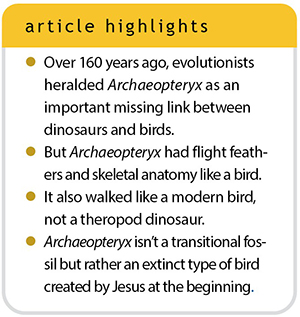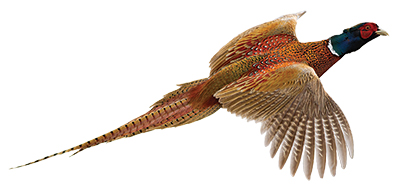 In 1860, one year after the publication of Charles Darwin’s On the Origin of Species, a wonderfully preserved fossil feather was discovered in the Jurassic Solnhofen Limestone in Germany. A year later, the first of 14 Archaeopteryx skeletons was found there.1 Named by paleontologist Hermann von Meyer, Archaeopteryx means “ancient wing,” a name implying it was a bird.1 Because all of the specimens were found in layers well below any other bird fossil, Archaeopteryx was raised to the evolutionary icon status of first bird.
In 1860, one year after the publication of Charles Darwin’s On the Origin of Species, a wonderfully preserved fossil feather was discovered in the Jurassic Solnhofen Limestone in Germany. A year later, the first of 14 Archaeopteryx skeletons was found there.1 Named by paleontologist Hermann von Meyer, Archaeopteryx means “ancient wing,” a name implying it was a bird.1 Because all of the specimens were found in layers well below any other bird fossil, Archaeopteryx was raised to the evolutionary icon status of first bird.
However, the feather impressions, claws on the wings, and a thin, bony tail caused many evolutionists to claim this was a transitional fossil between birds and dinosaurs. This view was further strengthened by the 1877 discovery of teeth in the beak of the second skeleton.1 Regardless, most scientists accepted it as essentially a bird—that is, until recently. Evolutionary scientists are now placing Archaeopteryx in the imaginary feathered dinosaur category.2
Archaeopteryx Flew Like a Bird
Evolutionary paleontologist Alan Feduccia has pointed out that the feathers on Archaeopteryx are completely aerodynamic in structure, indicative of flight.3 Furthermore, Archaeopteryx possessed a bird “wishbone” that was robust enough for muscle attachment and flight capability. In addition, the pubis bone in Archaeopteryx resembles that of birds living today and was probably used as a muscle attachment site for suprapubic muscles, which are designed to assist lung ventilation by moving the tail during roosting. By contrast, the pubis bone of crocodiles and bipedal dinosaurs functions as a muscle attachment site for diaphragmatic muscles.4

The flying issue was settled after scientists studied the cross-sectional geometry of wing bones from three Archaeopteryx specimens.4 They concluded Archaeopteryx flew like a pheasant, with quick ascents, a short flight time, and running as a way to evade danger.
Our analyses reveal that the architecture of Archaeopteryx’s wing bones consistently exhibits a combination of crosssectional geometric properties uniquely shared with volant [flying] birds, particularly those occasionally utilising shortdistance flapping. In effect, Archaeopteryx appears to have flown by flapping its wings in short bursts.5
Evolutionary paleontologist Steve Brusatte stated, “I think it’s a case closed now….Archaeopteryx was capable of at least short bursts of powered flight.”6
It’s quite clear Archaeopteryx was a fully designed bird that could fly directly from the ground. It possessed some unusual features for a bird, but it was a bird nonetheless.
Archaeopteryx Walked Like a Bird
A study of the socket (acetabulum) where the femur (thigh bone) meets the pelvis points to another major dissimilarity between birds and dinosaurs.7 It’s a powerful way to differentiate them. Why? Theropod dinosaurs had completely open holes in their hip sockets, and birds do not. Archaeopteryx was found to have a partially closed acetabulum, unlike that of dinosaurs.7
Also, tail muscles connected to a theropod’s femur pulled the leg back when the dinosaur walked. These muscles attached to the tail at the chevrons, small bones pointing downward from the tail vertebrae. Bonytailed birds like Archaeopteryx do not have large chevrons jutting down from the vertebrae on their tails. Also, birds’ thighs are mostly immobile when they walk. They instead move their leg bones below the knee.
Simply put, Archaeopteryx is not a transitional fossil or a feathered dinosaur. It flew like a bird and walked like a bird. Archaeopteryx is simply an extinct type of bird that was created by Jesus in the beginning.
References
- Shipman, P. 1998. Taking Wing: Archaeopteryx and the Evolution of Bird Flight. New York, NY: Simon and Schuster, 13.
- Johnson, J. S. 2021. Are Birds “Cousins” to Reptiles? Acts & Facts. 50 (12): 11.
- Feduccia, A. 2020. Romancing the Birds and Dinosaurs: Forays in Postmodern Paleontology. Irvine, CA: BrownWalker Press.
- Clarey, T. 2015. Dinosaurs: Marvels of God’s Design. Green Forest, AR: Master Books, 127.
- Voeten, D. F. A. E. et al. 2018. Wing Bone Geometry Reveals Active Flight in Archaeopteryx. Nature Communications. 9, article 923.
- Briggs, H. Archaeopteryx Flew Like a Pheasant, Say Scientists. BBC News. Posted on bbc.com March 18, 2018, accessed February 19, 2024.
- Feduccia, A. 2024. The Avian Acetabulum: Small Structure, but Rich with Illumination and Questions. Diversity. 16 (1): 20, 1–28.
Stage image: Archaeopteryx, Wyoming Dinosaur Center
Stage image credit: incidencematrix, CC BY 2.0. Used in accordance with federal copyright (fair use doctrine) law. Usage by ICR does not imply endorsement of copyright holder.
Dr. Clarey is the director of research at the Institute for Creation Research and earned his Ph.D. in geology from Western Michigan University.













